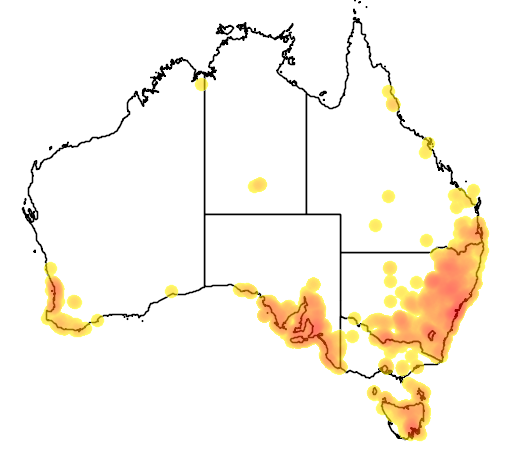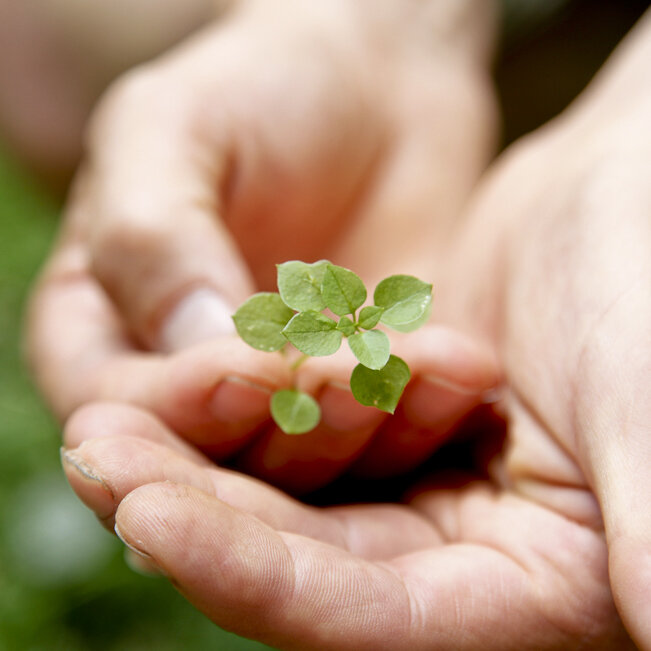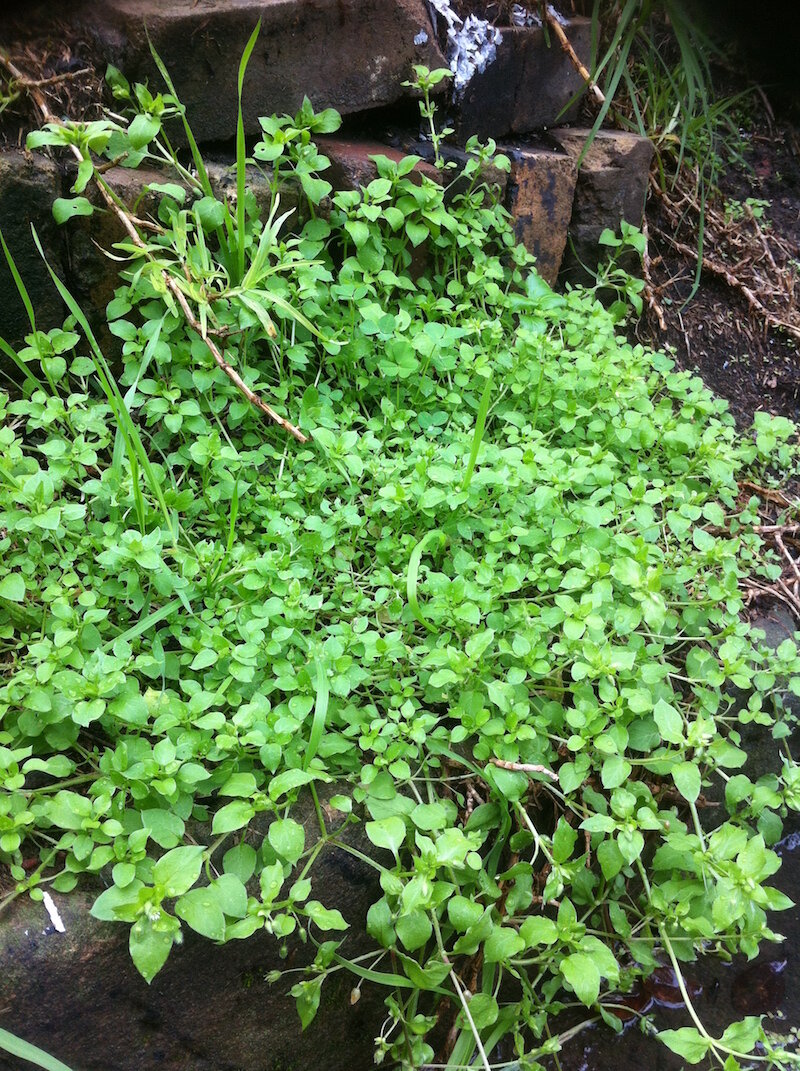Wonderful chickweed. And its poisonous lookalike.
It's getting colder on this side of the world, and as the temperature drops, the botany changes.
Species that disappear in the warmer months pop up and flourish everywhere now, and I wait every year for this season of plenty.
You see, here in the Sydney Basin it's kind of useless to understand cycles via imported seasons from the northern hemisphere, as the die-out here happens in summer, not winter. When the weather cools down a host of juicy, vitamin and mineral-rich plants pop up and I have been noticing that a great season marker is chickweed, Stellaria media.
Seasonal markers are important, as they are a tangible, visible presence attuned to changing patterns more that we could hope for. If you would like to know more about weather patterns in Australia I encourage you to spend some time learning about Indigenous Weather Knowledge. I write from Cadigal-Wangal country and over here we acknowledge the Dharrawal Calendar. See here. Right now, we just stepped into Marrai’gang season.
Chickweed is a little herbaceous plant that grows all over South Eastern Australia with records showing it growing all the way up into the tropics, see image below for the spread. It is a celebrated edible, outstanding medicine and easy to identify, once you know what to look for. So here goes, the hunt for chickweed begins>>>
Identification
Can you see the crest?
Check for the bone in the chickweed
Firstly I will give you the official blurb about the plant and then the story that I tell people. Both are good, but my hunch is that the story is what you’ll remember.
The official blurb: Chickweed is an annual herb, it lies along the ground and has slender stems. There is a single line of white hairs which run up the stems until they reach a joint (see image). The stems are round in cross-section. The leaves occur opposite and the lower leaves have stalks, are oval and taper to a pointy end, 1-3 cm long and 5-10 mm wide. The flowers are tiny, white and with 5 peculiar petals shaped like a ‘V’ (making it look like they are 10!). The fruit is an oval capsule with red-brown seeds inside.
The story I tell: To me, there are two great identification features for chickweed. One is the single line of hair on the stems. It looks like a mohawk or a mullet and it changes direction as the stems come to a joint. The best way to see this is you pick up a branch of chickweed and slowly roll it in your fingers, and there it is, on one side only of the stem, as if the plant was having a bad hair day. I call it a crest. You see, if it has a crest, then it is chickweed. Another peculiar feature of chickweed is inside the stems. If you gently break and pull apart the stem you will notice a core, like a string inside the branch. Chickweed has bones. So here’s the story: it is only chickweed if it shows a chicken crest and if you find a chicken bone.
Where it grows: Anywhere that is cool, shady and moist. Chickweed does not like hot and dry, so you will find it under your plants, sneaking amongst tall lawn, in and behind your pots and as an understory to your trees. Chickweed loves good, nutrient-rich loose soil and I often tell people that chickweed is not a weed but rather a badge of honour. If you have chickweed it is a sign that you are a good gardener.
Video tutorials
Chickweed
Radium weed
Chickweed as food
Young leaves and shoots, raw or cooked as a potherb, are delicious. Very nutritious, they can be added to salads whilst the cooked leaves can scarcely be distinguished from spring spinach. Seed – ground into a powder and used in making bread or to thicken soups. It would be very fiddly to harvest any quantity of this seed since it is produced in small amounts. The seed contains 17.8% protein and 5.9% fat. What people do most with chickweed is use it as a green in sandwiches and salads, as a side dish and/or garnish. Some people go to the trouble to pick only the leaves but most just eat the whole plant. Please be mindful as the plant gets older it gets more and more stringy. It comes to a point that it is not great food any longer. If it looks like a stick, most probably it will taste like a stick.
Medicinal properties
Chickweed has a very long history of herbal use, being particularly beneficial in the external treatment of any kind of itching skin condition. It has been known to soothe severe itchiness even where all other remedies have failed. Taken internally it is useful in the treatment of chest complaints and in small quantities it also aids digestion. It can be applied as a poultice to relieve skin rashes and is effective wherever there are fragile superficial veins. An infusion of the fresh or dried herb can be added to bathwater and its emollient property will help to reduce inflammation – in rheumatic joints for example – and encourage tissue repair. A decoction of the whole plant is taken internally as a post-partum depurative, and blood tonic. It is also believed to relieve constipation and be beneficial in the treatment of kidney complaints. The expressed juice of the plant has been used as an eyewash.
Contraindications: The plant contains saponin and, in excess doses, can cause diarrhoea and vomiting and it should not be used medicinally by pregnant women. If you’ve never tried it before just have a little, you might not like it after all.
I make salves with chickweed and plantain (Plantago lanceolata). It is super simple to do and when you make a batch it lasts for years. See below for the instructions. It has been so popular that it is known amongst my friends as the magic salve. True story. Excellent for anything due to the properties of both Stellaria and Plantago. Great for soothing irritated skin, ailing small cuts, lip balm, infected small wounds and more. It is my go-to salve for anything skin really. See below.
Chickweed and Plantain salve. Easy home remedy.
Chickweed and plantain skin salve
1. Collect and wash two handfuls of chickweed and two handfuls of plantain leaves, no roots. Let it dry fully. Chop finely and place the herbs in a jar. Fill the jar with good quality olive oil, making sure all herbs are submerged. Rest the jar in a warm place for 2-4 weeks, like on the window sill or the kitchen bench. Shake daily.
2. Strain the herbs well through a cotton cloth or cheesecloth, squeezing as much of the oil as possible out of the plant material.
3. Pour the extracted oil into a clean, dry saucepan, adding ½ cup of grated beeswax per every 4 cups of oil. Melt over a low flame, stirring constantly until the beeswax is fully dissolved.
4. Check for readiness by pouring 1 teaspoon of the product into a small clean glass jar and placing in the freezer for 3 to 5 minutes. The salve should be firm and solid without being so hard that it can not be melted into your skin. If the consistency is correct, then pour the salve into small jars, cool to room temperature, cover, label, and store. If your salve is too soft, add more beeswax; if it is too hard, add more oil.
It would keep for several years. I add a few drops of geranium essential oil to the salve so that it carries a nice relaxing scent with it.
Further information and reference:
Wikipedia: wikipedia.org/wiki/Stellaria_media
Plant for a Future: https://pfaf.org/user/plant.aspx?LatinName=Stellaria+media
Botanical: https://botanical.com/botanical/mgmh/c/chickw60.html
Beware of lookalikes!
Beware of the milk!
There are several closely related plants often referred to as chickweed, but which lack the culinary properties of plants in the genus Stellaria. Plants in the genus Cerastium are very similar in appearance to Stellaria and are in the same family (Carophyllaceae). Stellaria media can be easily distinguished from all other members of this family by examining the stems as it has fine hairs on only one side of the stem in a single band. Other members of the family Carophyllaceae which resemble Stellaria have hairs all over, covering the entire stem.
Another common mistake is radium weed, Euphorbia peplus, which often grows in similar conditions as chickweed. I have produced a video about radium weed as it is caustic and you do not want to eat it by mistake as it will burn your lips. The key identification feature is the milk. Chickweed will never have white milk coming out of it, radium weed does, see above for a video tutorial.
Do not despair if your garden is full of radium weed rather than chickweed as there are good things about this plant too. But that is for another post.
Have fun with chickweed and remember: it is only chickweed if it shows a chicken crest and if you find a chicken bone!
Yay, love weeds.
Disclaimer: This information should be used as a guide only. It is not my intention to advise anyone on medical conditions, rather I'm just presenting a new way to look at the plants growing in your yard.









